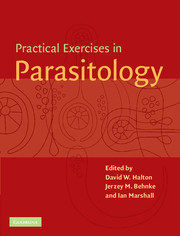Book contents
- Frontmatter
- Contents
- List of contributors
- Preface
- General advice
- 1 Observational Exercises on Parasites
- 2 Ecology
- 3 Physiology and Biochemistry
- 4 Pathology and Immunology
- 5 Chemotherapy
- 6 Molecular Parasitology
- 6.1 Purification of DNA
- 6.2 DNA digestion and gel electrophoresis
- 6.3 Restriction enzyme mapping
- 6.4 Construction of a genomic library
- 6.5 Detection and differentiation of Entamoeba histolytica and E. dispar by PCR
- 6.6 Differentiation between parasite species by agglutination and detection of parasite surface carbohydrates, using non-conjugated lectins
- 6.7 Tentative identification of parasite and tissue surface carbohydrates by conjugated lectins
- 7 Behaviour
- Appendix 1 Reagent index
- Appendix 2 UK suppliers
- Appendix 3 US suppliers
- Index
6.4 - Construction of a genomic library
Published online by Cambridge University Press: 05 June 2012
- Frontmatter
- Contents
- List of contributors
- Preface
- General advice
- 1 Observational Exercises on Parasites
- 2 Ecology
- 3 Physiology and Biochemistry
- 4 Pathology and Immunology
- 5 Chemotherapy
- 6 Molecular Parasitology
- 6.1 Purification of DNA
- 6.2 DNA digestion and gel electrophoresis
- 6.3 Restriction enzyme mapping
- 6.4 Construction of a genomic library
- 6.5 Detection and differentiation of Entamoeba histolytica and E. dispar by PCR
- 6.6 Differentiation between parasite species by agglutination and detection of parasite surface carbohydrates, using non-conjugated lectins
- 6.7 Tentative identification of parasite and tissue surface carbohydrates by conjugated lectins
- 7 Behaviour
- Appendix 1 Reagent index
- Appendix 2 UK suppliers
- Appendix 3 US suppliers
- Index
Summary
Aims and objectives
This exercise is designed to demonstrate the construction of a simple genomic DNA library. It can be adapted for use with any organism including parasites. The version given here is for the construction of a Plasmodium falciparum library.
The specific objectives of this exercise are:
To perform a ligation reaction.
To prepare competent E. coli cells.
To transform and plate these competent cells.
To grow small-scale cultures from recombinant colonies.
To prepare plasmid DNA from recombinants.
To analyse recombinant plasmids by agarose gel electrophoresis.
Introduction
The work to be described is aimed at the construction of a genomic library from an isolate of P. falciparum such as might be undertaken to analyse a specific gene. This type of cloning experiment is fundamental to a whole range of analyses in molecular biology.
Laboratory equipment and consumables
(per student or group)
Equipment
P20, P200 and P1000 Gilson pipetmen or equivalents
Waste beaker for chemically contaminated plasticware
Autoclavable waste bags for bacterially contaminated waste 37°C, 42°C and 65°C waterbaths
Bench-top centrifuge capable of producing 1000g 37°C incubator, static and orbital
Vortex machine
‘Camping gaz’ and lighter
Vacuum pump and desiccator
Eppendorf microfuge or equivalent
Heater/stirrer and magnetic stirring bar
Agarose gel electrophoresis apparatus and combs
Power supply for running gels
Photographic system for recording results
Safety glasses
- Type
- Chapter
- Information
- Practical Exercises in Parasitology , pp. 357 - 364Publisher: Cambridge University PressPrint publication year: 2001



